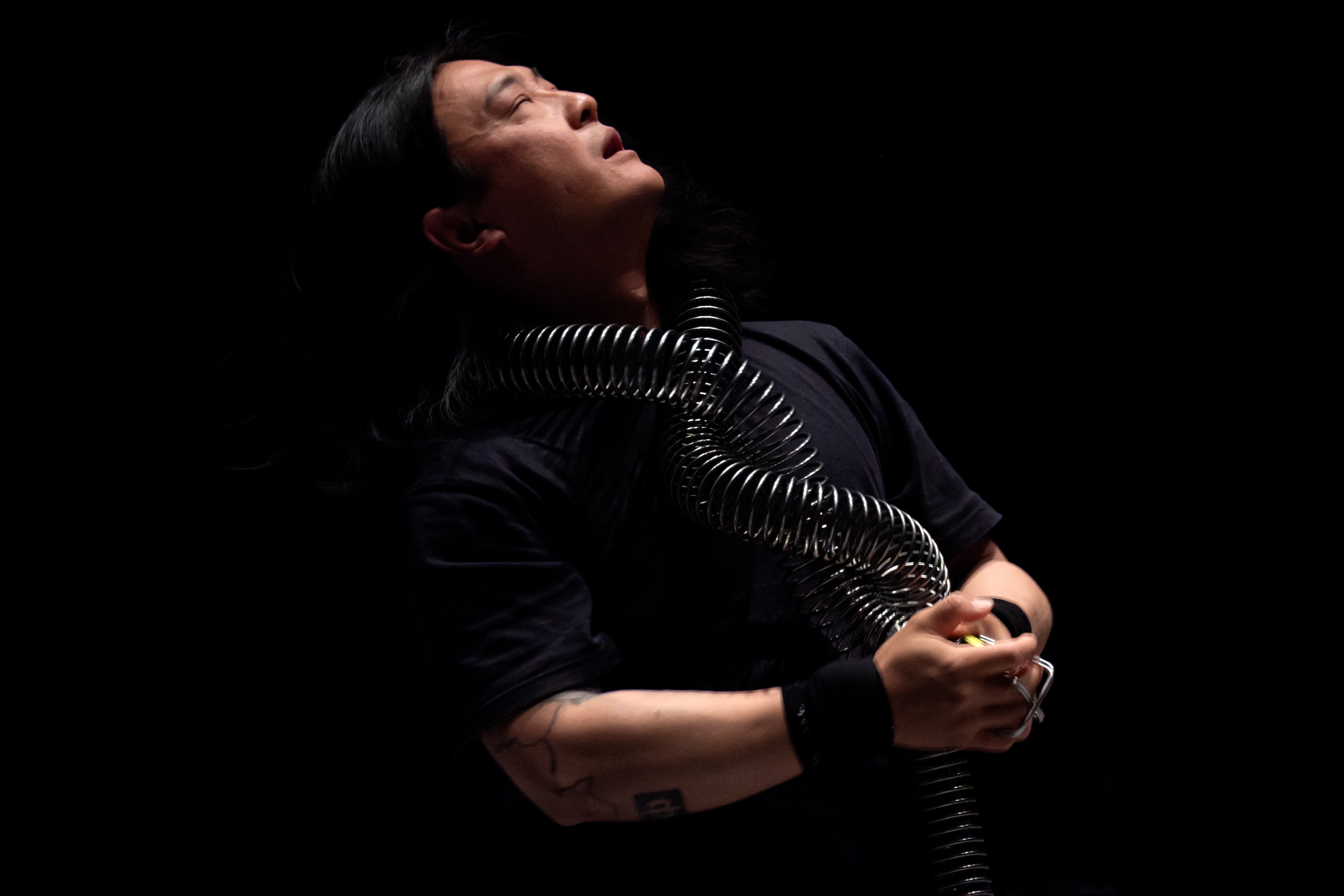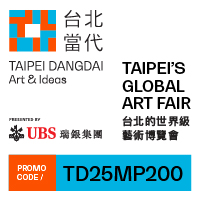Highlights from Freespace Noise Fest
By Alex Yiu
Performance of LARRY SHUEN’s lecture performance on Gesture Studies, 2021- , ongoing research, at Freespace Noise Fest, The Room, on July 26, 2024. Photo by tsunwinston. Courtesy the photographer.
Freespace Noise Fest
The Room
Freespace, WestK
Hong Kong
Jul 26–Aug 6
In recent history, experimental music and sound practices (or “sound art”) have gained increasing attention in performance and visual art spaces. Artists such as Susan Philipsz, Samson Young, Pan Daijing, Lawrence Abu Hamdan, Tarek Atoui, and others who experiment with sound frequently appear in museums, biennials, and art fairs. Although these disciplines were once debated and demarcated by scholars Alan Licht, Douglas Kahn, and Brandon Labelle, in the past decade they have become more visible through institutional inclusion, as evidenced by the Museum of Modern Art in New York’s exhibition “Soundings: A Contemporary Score” in 2013 and the opening of the Sound Art Museum in Beijing in 2023. Yet audio-centric art remains less prioritized in practice. Many institutions have yet to survey, to develop an institutional discourse, or provide training and outreach for the aural experience.
In defense of such institutions, sound-based practices require a different epistemology, one that spans the material, the compositional, and the sociohistorical. A specialty on its own, sound art diverges from the visual format as its ephemeral nature unsurprisingly aligns more closely with durational performance than static representation. Many renowned research institutions, such as the Institute for Research and Coordination in Acoustics/Music in Paris and the Institute of Sonology in The Hague, solely prioritize academic research and education and are closely affiliated with conservatories. On the other side of the aisle, experimental music festivals such as CTM in Berlin, Unsound in Krakow, and MUTEK in Montreal, though reputable for showcasing these evolving practices on large stages, tend to primarily feature electronic music, which prioritizes approachable sound over alternative practices (harsh noise, free improvisation) and forces performers into a peripatetic search for underground boutique festivals and alternative venues.

Performance of KELVIN T at Freespace Noise Fest, The Room, on July 27, 2024. Photo by Axel Ling. Courtesy the photographer.
In this context, the Freespace Noise Fest at WestK (formerly, the West Kowloon Cultural District), in collaboration with local institutions such as Contemporary Musiking Hong Kong, PROJECT21st, and Twenty Alpha, embraced the niche. The festival established a six-day program across two weekends at the harborside venue The Room, bringing together more than 20 artists from diverse backgrounds, including academic composers, noise musicians, audiovisual artists, computer programmers, and even rave DJs, ambitiously demonstrating various approaches to sound-based performances that ranged from the alternative to the esoteric.
Within the lineup, composers and musicians from conservatories maintained a strong presence. Many of them, however, appeared to question the legitimacy of Eurocentricism in Western classical music. In the first show that kickstarted the festival on July 26, composer and media artist Larry Shuen presented a lecture performance on musical gestures and expressions in classical music, supplemented by works from his ongoing research project Gesture Studies (2021– ). Between his scripted lecture, in short acts Shuen mimicked the exaggerated gestures of classical musicians and maestros. Meanwhile, live footage of his hand movements (captured by a camera) was overlaid onto found footage of professional musicians performing on YouTube, resulting in a whimsical critique of the authority in conservatoires that is underpinned by classical music’s lineage.
Performance of VICA PACHECO’s Ollin, 2023, ceramic water whistles designed by the artist, performers, at Freespace Noise Fest, The Room, on July 26, 2024. Photo by tsunwinston. Courtesy the photographer.
On the same night, Mexican artist Vica Pacheco, who holds strong convictions about the urgency of decolonization, presented a group piece titled Ollín (2023), meaning “constant movement” in the Nahuatl language. In collaboration with Hong Kong choreographer Ching Chu, who led a group of local performers improvising with ceramic water whistles custom-made by Pacheco, the artist reimagined a distant wilderness by creating an evolving soundscape with laptop-processed vocals. Adding to the scene was the chimeric and phallic design of her instruments and the Dionysian gestures of performers, alluding to an imaginary precolonial landscape. Ollín thus enacted a “sonic orgy” that rejected Western musical idioms.
When considering performance as a form of engagement, for some artists breaking the fourth wall becomes a task to subvert the stage’s unilateral nature. This was shown in the Berlin-based Hong Kong guitarist and electronic musician Eric Wong’s new work Solo (2024), from his Bluetooth Speakers series (2018– ). In his performance on July 28, which included dozens of Bluetooth speakers hidden among the audience, the artist instructed us to find and play with them, transforming the moment into a sonic hide-and-seek. From Wong’s laptop station, the artist controlled the sound, from emitting pulsating beeping attacks to sustaining high notes. In this process, the acoustic phenomenon was exaggerated by participants covering, shaking, and even placing the speakers far away from themselves, resulting in an overwhelming surround-sound experience. A rare sight that stands out from many laptop musicians (whose stoic appearance over their computers often result in lethargy), Wong’s work opened up an unexpectedly collective engagement.
%20KEN%20UENO%20and%20KUNG%20CHI%20SHING%20at%20Freespace%20Noise%20Fest,%20The%20Room,%20on%20Aug%203,%202024.%20Photo%20by%20Axel%20Ling.%20Courtesy%20West%20Kowloon%20Cultural%20District%20Authority.jpeg)
Performance of (left to right) KEN UENO and KUNG CHI SHING at Freespace Noise Fest, The Room, on Aug 3, 2024. Photo by Axel Ling. Courtesy West Kowloon Cultural District Authority.
While Wong’s work rightfully highlighted the importance of location in relation to sound, free improvisation is another tenet of experimental music practice. Attributed to free jazz in America and mid-20th century European avant-garde music, improvisation necessarily demonstrates performers’ instinctive reactions, which is a testament to their sonic vision and ability. It was thus no surprise that, throughout the festival, improvisation featured heavily. During the night performances on July 27 organized by Twenty Alpha, an experimental sound venue in Hong Kong’s Foo Tak Building, the underground music producer Kelvin T used electronics-on-table to conjure a collision of sound, fusing hard electronic drums and harsh noise mixed with distorted vocals, turning the floor into a euphoric dance pit. On the night of August 3, American composer and vocalist Ken Ueno, with longtime Hong Kong experimentalist Kung Chi Shing, staged a duet alternating between Ueno’s desperate throat singing, amplified screaming, microphone tapping, and Kung’s bewitched playing on the violin and various bamboo flutes. On the same night, two members of the Taiwanese trio Buddha Tiger Dog, who performed in The Psychedelic Spiritual Ceremony (2023) by Taiwanese artist Li Jiun-Yang at the Taipei Biennial 2023, featured a hybrid soundscape of unorthodox turntablism, dazzling saxophone, and pre-recorded footage of the third member playing a bowed instrument DIY-ed with metal scraps, showcasing their innate musical connection.
Approaching further climaxes on the night of August 4, exponential and totalizing impacts struck our aural perception. Chinese harsh noise artist Mei Zhiyong tied himself up with a coil spring: as a wireless microphone sent signals from the metal instrument to a multi-effects pedal, an extreme soundscape emerged, intensified further when the artist strangled his body with the instrument while rolling on the floor, alluding to the violent elation of pain-induced suffocation. In the final showcase, the bending guitar licks of the eminent Beijing-based noise guitarist Li Jianhong dominated the atmosphere as he strummed the strings over a chain of processing units, accompanied by a strenuous synth rhythm from the Hong Kong-based legendary musician Nelson Hiu. Almost overpowered by Li, Hiu often took space between Li’s raunchy guitar, impressing the audience with blissful colors emitted by his synthesizers.

Performance of MEI ZHIYONG at Freespace Noise Fest, The Room, on August 4, 2024. Photo by Axel Ling. Courtesy West Kowloon Cultural District Authority.
Featuring over 30 performances over two weekends and a dense program including artists’ talks and workshops in collaboration with other organizations, Freespace Noise Fest was unprecedented for Hong Kong. Perhaps the event was a reaction to the city’s ever-changing underground scene, especially considering that most alternative spaces dedicated to experimental practice vanish shortly after emerging due to Hong Kong’s hefty costs, noise restrictions, and limited spaces, among other factors. And despite not being fashionable to most subversive artists, the institutional support the festival received opened up further exposure to alternative practices, potentially kickstarting renewed dialogue and artistic development on these underrepresented art forms. If allowed, the festival ought to continue and be expanded to align with the growing worldwide prominence and significance of sound-oriented art forms, which follow a long history of experimental arts.
Alex Yiu is associate editor at ArtAsiaPacific.







